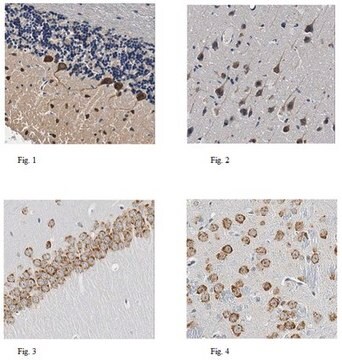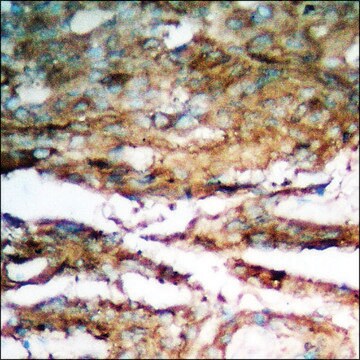MAB347
Anti-Growth Associated Protein 43 Antibody, clone 9-1E12
clone 9-1E12, Chemicon®, from mouse
Sinónimos:
Neuromodulin, B-50 Protein, Growth Associated Protein 43, neuromodulin
About This Item
Productos recomendados
biological source
mouse
Quality Level
antibody form
purified immunoglobulin
antibody product type
primary antibodies
clone
9-1E12, monoclonal
species reactivity
feline, rat, hamster
species reactivity (predicted by homology)
human
manufacturer/tradename
Chemicon®
technique(s)
immunohistochemistry: suitable
immunoprecipitation (IP): suitable
western blot: suitable
isotype
IgG1
NCBI accession no.
UniProt accession no.
shipped in
wet ice
target post-translational modification
unmodified
Gene Information
human ... GAP43(2596)
General description
Specificity
Immunogen
Application
0.1-0.5 µg/mL of a previous lot on 4% paraformaldehyde perfused and fixed rat cerebellum and cerebrum tissue. The addition of 0.01-0.1% Triton X-100 to incubation buffer will increase cellular permeability.
Immunoprecipitation:
A previous lot of this antibody was used in immunoprecipitation.
5-10µg/mL in membrane preparations from 16-18 day embryonic cortical neuronal cultures.
Western Blot Analysis:
MAB347 will detect a single 43-48 kD band in western blots of membrane fractions of growing neurons.
Optimal working dilutions must be determined by the end user.
Neuroscience
Neuroregenerative Medicine
Quality
Western Blot Analysis:
1:1000 dilution of this lot detected GAP-43/B-50 on 10 μg of rat brain lysates.
Target description
Physical form
Storage and Stability
Analysis Note
Rat DRG tissue that has been subjected to a spinal nerve ligation and cultured neurons.
Other Notes
Legal Information
Disclaimer
¿No encuentra el producto adecuado?
Pruebe nuestro Herramienta de selección de productos.
Optional
Storage Class
10 - Combustible liquids
wgk_germany
WGK 2
flash_point_f
Not applicable
flash_point_c
Not applicable
Certificados de análisis (COA)
Busque Certificados de análisis (COA) introduciendo el número de lote del producto. Los números de lote se encuentran en la etiqueta del producto después de las palabras «Lot» o «Batch»
¿Ya tiene este producto?
Encuentre la documentación para los productos que ha comprado recientemente en la Biblioteca de documentos.
Nuestro equipo de científicos tiene experiencia en todas las áreas de investigación: Ciencias de la vida, Ciencia de los materiales, Síntesis química, Cromatografía, Analítica y muchas otras.
Póngase en contacto con el Servicio técnico








